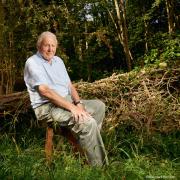How a trip to paint African wildlife inspired this Kent artist
Arriving early at Paul Apps’ studio in a little back street of Hythe, I sit quietly to pass the time and can’t help but become absorbed by the sense of tranquil study.
Neatly laid out on a central table are books on painting dogs and puppies and leaflets advertising the many courses Paul teaches a year.
An elephant painting adorns the easel, accompanied by an open box of multi-shaded pastels. On an adjoining table are paintbrushes, a razor and sticking tape and around the walls are the fruits of his labours.
I am especially fond of the seascapes as well as the landscapes of African wildlife including lions, zebras and buffaloes.
In addition to this prolific work, Paul also writes for publications such as Art of England and the SAA (Society for All Artists) magazines. He’s recently taken up positions with The Artist and The Leisure Painter.
Paul has been in his current studio space for two years now, moving down from home in Saltwood, where he had lived for 11 years. Although he is active as a teacher, he is ambivalent about the value of formal art training.
“From people I’ve spoken to, it’s nice to have the letters, but it often doesn’t help in the industry. Endeavour is a better way forward.”
“Someone who goes into the art college system may have no knowledge of the grounding and mechanics of art. Even in my two years in Hythe, I have had BA students come to learn about line and colour.”
Paul’s advice to a young painter starting out is simply just to “go for it”. He does add, however: “But only if you have the means to support yourself, as there are no artists who can afford to take on apprentices. It can be quite a long journey but the rewards are worth it.”
Paul paints with oil and pastel predominantly but he has also done demonstrations at trade shows for the acrylics company Liquetex.
He considers pastel his secondary medium, not having used it for 20 years or so, but recently he has gone back to see if he still has the old techniques.
The advantage of oil is that it is adaptable and versatile enough to mix, blend and soften edges and create textures. As Paul says: “You can go back to it the next day and work on it, but with acrylic it’s more difficult to get a good blend.
“Oils get a bad press because of the solvents needed to use it, but when you can manipulate them, they produce such great pieces.”
The advantages of pastels, however, are that you can mix it on the painting itself, whereas with oil paint you mix on a palette and instead of mixing your colour, you find it in the mix you have.
“When you mix oil, you temper it and that can lead to paintings that are a little on the dull side,” admits Paul.
“When you have pastels, there’s a good range of some 400 colours, although an artist will use about 100. With pastels, because you can’t ever get what you’re looking for, you have to settle for the nearest; paradoxically that can improve your colour.”
Paul has been drawing since he was a schoolboy, often competing with a close friend on who could paint the best airplane. Now he is known as a wildlife artist, inspired earlier on by David Shepherd’s Wise Old Elephant.
“I started to copy it,” he says. “I used to paint eggs, insects and at 10 I was campaigning to Save the Whale.”
Writing to David Shepherd in person, Paul was encouraged to go out and look for himself. The catalyst came in 1987, when a couple told him he didn’t know how to paint animals and that he should go out to Africa.
They subsequently invited him on a trip, so off he went with rolls of film and has never looked back. His technique is a mix of observation and reference to his archive of photos.
“You only use photographs as an aid, but from experience you learn the nuances that change the painting from average to good,” he says.
Paul was also a frequent visitor to nearby Port Lympne, where the late owner John Aspinall would let him come and paint.
Interspersed among his finished lots are smatterings of sketches so I ask him how long it takes to finish one single piece of work. His answer is profound: “It has taken all my life, because the completion of the work is in the sum total of all my learning.” n



























